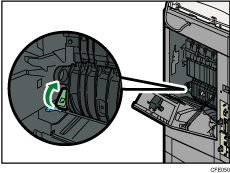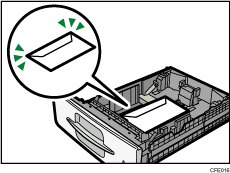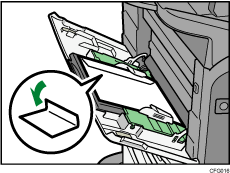Envelopes
This section gives you various details about and recommendations concerning envelopes.
![]()
Misfeeds might occur depending on the length and shape of the flaps.
Do not use window envelopes.
When loading envelopes in trays 1 - 4 or the bypass tray, open the rear cover, and then raise the envelope lever.

Load envelopes in the portrait (![]() ) orientation and print side down with their flaps closed and facing the left side of the machine.
) orientation and print side down with their flaps closed and facing the left side of the machine.
Trays 1
 4
4
Bypass tray

When copying onto envelopes, see “Copying onto Envelopes from Trays 1 - 4” or “Copying onto Envelopes from the Bypass Tray”, Copy and Document Server Reference.
When printing onto envelopes, see “Setting Envelopes Using the Control Panel”, Printer Reference.
The following sizes can be used: 41/8 × 91/2![]() , 37/8 × 71/2
, 37/8 × 71/2![]() , C5 Env
, C5 Env![]() , C6 Env
, C6 Env![]() , DL Env
, DL Env![]()
![]()
Load only one size and type of envelope at a time.
Before loading envelopes, press down on them to remove any air from inside, flatten out all four edges. If they are bent or curled, flatten their leading edges (the edge going into the machine) by running a pencil or ruler across them.
Fan the envelopes before loading them to separate them and prevent the glue on them from causing them to stick together.
Some kinds of envelope might cause misfeeds, wrinkles or print poorly.
Print quality on envelopes may be uneven if parts of an envelope have differing thicknesses. Print one or two envelopes to check print quality.
To get better print quality, it is recommended that you set the leading-edge print margin to at least 15 mm (0.6 inches) and the other margins to at least 10 mm (0.4 inches) each.
High temperature and high humidity conditions can reduce print quality and cause envelopes to become creased.

